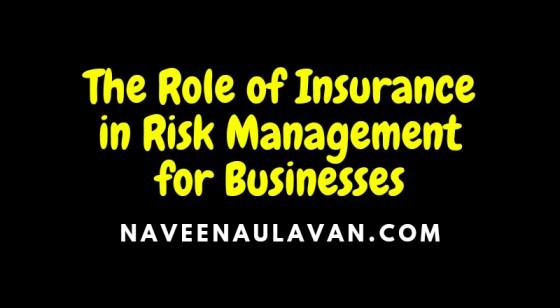Risk is an inherent aspect of every business operation. Whether it’s a small start-up or a multinational corporation, businesses face various uncertainties that can disrupt their operations and financial stability. The ability to manage and mitigate these risks effectively is crucial for sustainable growth and success. Insurance plays a pivotal role in a comprehensive risk management strategy, providing protection against unforeseen events and offering peace of mind to business owners and stakeholders. In this article, we will delve into the significant role of insurance in risk management for businesses, exploring its benefits, types, and best practices.
Understanding Risk Management
Before we delve into the role of insurance, it is essential to grasp the concept of risk management. Risk management is the process of identifying, assessing, and prioritizing potential risks that can impact a business and taking appropriate actions to minimize or control them. This proactive approach enables businesses to enhance their decision-making processes, maintain financial stability, and safeguard their assets.
The Importance of Insurance in Risk Management
Insurance is a crucial component of a well-rounded risk management strategy. It acts as a safety net, transferring the financial burden of potential losses to an insurance provider in exchange for premium payments. The significance of insurance in risk management can be highlighted through the following key points:
Financial Protection
Insurance protects businesses from significant financial losses resulting from unexpected events such as natural disasters, accidents, theft, liability claims, and more. By covering these losses, insurance helps businesses maintain their financial stability and continuity.
Legal Compliance
In many jurisdictions, certain types of insurance coverage are legally required for businesses to operate. For instance, workers’ compensation insurance is mandatory in many regions to protect employees in case of job-related injuries or illnesses.
Business Continuity
In the face of unforeseen events, insurance enables businesses to recover and resume operations without suffering a total financial collapse. This resilience is particularly crucial for small and medium-sized enterprises (SMEs) that may lack substantial reserves to absorb substantial losses.
Stakeholder Confidence
Having comprehensive insurance coverage can instill confidence in investors, lenders, and other stakeholders. It demonstrates that the business has taken adequate measures to mitigate risks and protect their interests.
Types of Insurance for Businesses
Property Insurance
Property insurance provides coverage for physical assets such as buildings, machinery, equipment, and inventory. It protects businesses from losses due to fire, theft, vandalism, natural disasters, and other covered perils.
Liability Insurance
Liability insurance covers the legal obligations and financial responsibilities that a business may face in case of third-party claims for injuries, property damage, or negligence. It includes general liability insurance, professional liability insurance (errors and omissions), product liability insurance, and more.
Business Interruption Insurance
Business interruption insurance compensates for lost income and operational expenses when a covered event, such as a fire or natural disaster, forces a business to suspend its operations temporarily.
Workers’ Compensation Insurance
Workers’ compensation insurance provides medical benefits and wage replacement to employees who suffer work-related injuries or illnesses. It helps businesses fulfill their legal obligations while protecting employees’ well-being.
Cyber Insurance
With the increasing reliance on technology, cyber insurance has become crucial. It protects businesses from the financial consequences of cyberattacks, data breaches, and other cyber incidents.
Directors and Officers (D&O) Insurance
D&O insurance offers financial protection to company directors and officers against lawsuits and claims alleging wrongful acts, errors, or omissions in their managerial roles.
Best Practices in Utilizing Insurance for Risk Management
Assessing Risk Exposure
Before choosing insurance policies, businesses should conduct a comprehensive risk assessment to identify potential threats and vulnerabilities. Understanding the specific risks the business faces allows for the selection of appropriate insurance coverage.
Tailoring Coverage to Business Needs
Not all businesses have the same risk profile, and insurance needs may vary accordingly. Tailoring insurance coverage to match the specific risks and operational characteristics of the business ensures optimal protection.
Working with Reputable Insurers
Selecting a reliable and reputable insurance provider is essential for seamless claims processing and adequate coverage. Researching insurers’ financial strength, customer reviews, and claims handling track record can help businesses make informed decisions.
Regularly Reviewing Coverage
As businesses evolve and grow, their risk profiles may change. It’s crucial to review insurance coverage periodically to ensure it aligns with the current needs and circumstances of the business.
Risk Mitigation Measures
Insurance should not be the sole risk management tool; businesses should also implement risk mitigation measures to reduce the frequency and severity of potential losses. This may include safety protocols, employee training, and cybersecurity measures.
Conclusion
In conclusion, insurance plays a vital role in risk management for businesses, providing financial protection, legal compliance, and business continuity. By understanding the different types of insurance available and adopting best practices in utilizing them, businesses can strengthen their resilience against uncertainties and focus on sustainable growth and success. A well-thought-out insurance strategy, combined with other risk management measures, ensures that businesses are well-prepared to navigate the challenges that lie ahead.
